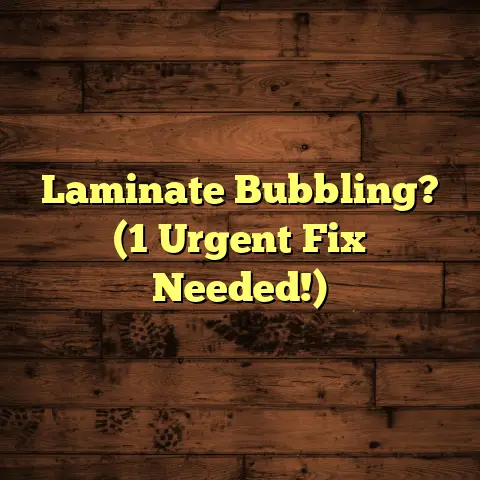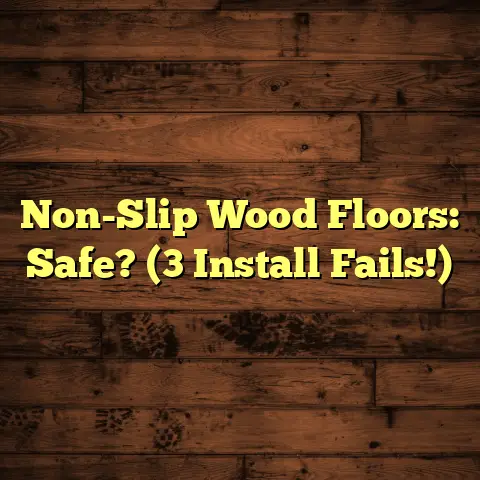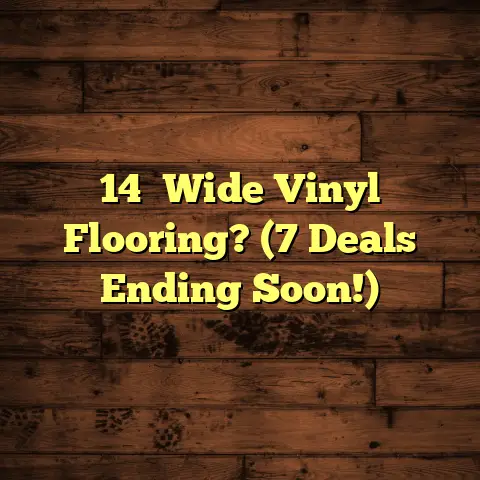Wooden Floor Myths Debunked (5 Flooring Fails!)
I remember one house in particular. The living room… oh, the living room!
It was filled with outdated, scratched, and dull wooden floors. Honestly, they didn’t just detract from the room’s aesthetic; they sucked the life right out of it!
The floorboards were warped in places, the colors had faded over time, and the whole space felt cramped and unwelcoming. It was a total mood killer.
Now, picture this: same room, completely transformed. The wooden floors have been beautifully restored and polished.
They shine under the natural light, showcasing the vibrant colors of the wood. The surface is smooth, and the space now feels open, inviting, and warm.
It’s like a breath of fresh air. The homeowners? They’re beaming, proud to show off their revitalized space to friends and family.
That’s the power of good flooring! But so often, homeowners are held back by myths and misconceptions about wooden floors.
As a flooring contractor with years of experience, I’ve heard them all. And trust me, some of them are real doozies.
That’s why I’m here today – to bust those myths and help you make informed decisions about your flooring.
Ready to dive in? Let’s get started!
Myth #1: Wooden Floors Are Too Expensive to Maintain
Okay, let’s tackle the big one right off the bat: “Wooden floors are too expensive to maintain.”
This is a common perception, and I get it. You see the initial cost of installation, and you might think, “Ouch! My wallet is already crying!”
But here’s the thing: wooden floors are an investment, not just an expense. Think of it like buying a good quality car versus a cheap one.
The initial cost might be higher for the better car, but it will last longer, require fewer repairs, and hold its value better over time.
Wooden floors are the same.
Let’s break down the costs. Sure, you’ll need to factor in regular cleaning supplies like wood floor cleaner (I recommend Bona, by the way – it’s my go-to).
You might also want to invest in a good quality mop and perhaps a floor buffer for occasional deep cleaning.
But compared to the ongoing costs of replacing carpets every few years due to wear and tear, stains, or allergies, wooden floors are a much more economical choice in the long run.
And don’t forget the value they add to your home! According to the National Association of Realtors, hardwood flooring can increase a home’s resale value by as much as 2.5%. National Association of Realtors
Plus, with proper care, a well-maintained wooden floor can last for decades, even centuries! I’ve seen floors in historical homes that are still going strong after hundreds of years.
Here’s a little table to illustrate the point:
| Flooring Type | Initial Cost (per sq ft) | Avg. Lifespan | Maintenance Costs (per year) |
|---|---|---|---|
| Carpet | $3 – $10 | 5-10 years | $50 – $150 |
| Vinyl | $2 – $7 | 10-20 years | $30 – $100 |
| Hardwood | $8 – $25 | 25-100+ years | $75 – $200 |
Note: Costs are estimates and can vary based on location, materials, and installation.
So, yeah, the initial investment might be a bit higher, but the longevity and value added by wooden flooring far outweigh the costs.
Don’t let that “expensive to maintain” myth scare you away! With a little TLC, your wooden floors will be looking beautiful for years to come.
Myth #2: All Wood Floors Are the Same
Alright, let’s move on to Myth #2: “All wood floors are the same.” Oh boy, where do I even begin?
This is like saying all cars are the same because they all have four wheels and an engine. It’s a massive oversimplification!
The truth is, there are significant differences between solid hardwood, engineered wood, and laminate flooring. And understanding those differences is crucial for making the right choice for your home.
Solid Hardwood: This is the real deal – planks made from a single piece of wood. It’s durable, beautiful, and can be refinished multiple times, giving it a lifespan of potentially over 100 years.
But it’s also the most expensive option and can be susceptible to moisture damage.
Engineered Wood: This consists of a thin layer of real wood veneer bonded to a core of plywood or fiberboard.
It’s more stable than solid hardwood, making it a good choice for areas with high humidity or temperature fluctuations. It’s also less expensive than solid hardwood.
However, it can only be refinished a limited number of times, depending on the thickness of the veneer.
Laminate Flooring: This is a synthetic product made to look like wood. It’s the most affordable option and is very durable and scratch-resistant.
But it doesn’t have the same warmth and character as real wood, and it can’t be refinished.
Here’s a quick comparison table:
| Feature | Solid Hardwood | Engineered Wood | Laminate Flooring |
|---|---|---|---|
| Material | Solid Wood | Wood Veneer | Synthetic |
| Cost | High | Medium | Low |
| Durability | High | Medium | High |
| Water Resistance | Low | Medium | Medium/High |
| Refinishing | Multiple | Limited | None |
| Lifespan | 25-100+ years | 20-50 years | 10-25 years |
Choosing the wrong type of flooring because you think “wood is wood” can lead to some serious problems down the road.
Imagine installing solid hardwood in a basement with high humidity. You’ll likely end up with warped and damaged floors.
Or, installing laminate flooring in a high-traffic area expecting it to last a lifetime. You’ll probably be disappointed when it starts to show wear and tear after a few years.
So, do your research! Understand the differences between these types of flooring and choose the one that best suits your needs and lifestyle.
Don’t fall for the “all wood floors are the same” myth! Your floors (and your wallet) will thank you.
Myth #3: Wooden Floors Aren’t Good for Allergies
Okay, let’s tackle another common misconception: “Wooden floors aren’t good for allergies.”
This one always makes me chuckle because, in many ways, it’s the opposite of the truth!
The belief that wooden floors exacerbate allergy issues stems from the idea that they collect dust and allergens. And while it’s true that any surface can collect dust, wooden floors actually offer some significant advantages over carpets when it comes to allergy control.
Think about it: carpets are like giant dust traps. They have fibers that allergens like dust mites, pet dander, and pollen can cling to. And once those allergens are trapped, they can be difficult to remove completely, even with regular vacuuming.
Wooden floors, on the other hand, have a smooth, non-porous surface that doesn’t trap allergens as easily.
Dust and other particles tend to sit on top of the floor, making them easy to sweep, mop, or vacuum away.
In fact, several studies have shown that wooden floors can actually improve indoor air quality compared to carpets.
According to the EPA (Environmental Protection Agency), hard surface flooring like wood is less likely to harbor allergens, mold, and pests than soft flooring like carpet. Environmental Protection Agency
Of course, cleaning and maintenance are key. Regular sweeping and mopping are essential for keeping your wooden floors free of dust and allergens.
I also recommend using a vacuum with a HEPA filter to remove any remaining particles.
And if you have pets, be sure to clean up any accidents promptly to prevent stains and odors.
Here are a few tips for allergy-friendly wood floor maintenance:
- Sweep or vacuum regularly: At least once a week, more often if you have pets or allergies.
- Mop with a damp mop: Use a wood floor cleaner recommended by the manufacturer.
- Use a HEPA filter vacuum: This will trap even the smallest particles.
- Control humidity: Keep humidity levels between 30-50% to prevent mold growth.
- Consider an air purifier: This can help remove airborne allergens.
So, don’t let the myth that wooden floors are bad for allergies scare you away.
With proper cleaning and maintenance, they can actually be a healthier choice than carpets, especially for allergy sufferers.
Myth #4: You Can’t Use Wood Floors in Wet Areas
Alright, let’s tackle another big one: “You can’t use wood floors in wet areas.”
This is a myth that has been around for a long time, and I understand why. Wood and water don’t always mix well.
But advances in technology and new water-resistant wood options have changed the game.
While I wouldn’t recommend installing traditional solid hardwood in a bathroom or kitchen (unless you’re prepared to be extra vigilant about spills and moisture), there are several alternatives that can provide the beauty and warmth of wood without the risk of water damage.
Engineered Wood: As I mentioned earlier, engineered wood is more stable than solid hardwood, making it a better choice for areas with high humidity or temperature fluctuations.
Look for engineered wood with a waterproof core for even greater protection against moisture.
Waterproof Laminate: This is a relatively new product that combines the look of wood with the waterproof properties of vinyl. It’s a great option for bathrooms, kitchens, and laundry rooms.
Luxury Vinyl Plank (LVP): While not technically wood, LVP can mimic the look of wood incredibly well. It’s 100% waterproof, durable, and easy to maintain.
I’ve installed LVP in countless kitchens and bathrooms, and my clients have been thrilled with the results.
Proper Sealing is Key: No matter what type of wood flooring you choose for a wet area, proper sealing is essential.
This will help protect the wood from moisture and prevent water from seeping into the seams.
I recommend using a high-quality polyurethane sealant specifically designed for wood floors.
Here are a few tips for using wood floors in wet areas:
- Choose the right type of flooring: Engineered wood, waterproof laminate, or LVP are all good options.
- Seal the floors properly: Use a high-quality polyurethane sealant.
- Clean up spills immediately: Don’t let water sit on the floor for extended periods.
- Use rugs in high-traffic areas: This will help protect the floors from wear and tear.
- Ventilate the room: Use a fan or open a window to help dry out the room after showering or bathing.
I remember one client who was hesitant to install wood floors in her kitchen because she had always heard they were a bad idea.
I recommended LVP that looked just like reclaimed hardwood. She was initially skeptical, but after seeing the finished product, she was absolutely blown away.
She loved the look of the wood, and she didn’t have to worry about water damage from spills or splashes.
So, don’t let the myth that you can’t use wood floors in wet areas hold you back. With the right products and proper installation, you can enjoy the beauty and warmth of wood in any room of your home.
Myth #5: Refinishing Wooden Floors Is Too Complicated
Last but not least, let’s bust the myth that “Refinishing wooden floors is too complicated.”
I get it. The thought of sanding, staining, and sealing your floors can seem daunting.
Many homeowners shy away from refinishing because they think it’s too difficult, time-consuming, or expensive.
But the truth is, refinishing wooden floors is a manageable project that can dramatically improve the look and value of your home.
And while it does require some time and effort, it’s not nearly as complicated as you might think.
Here’s a step-by-step overview of the refinishing process:
- Preparation: Clear the room of all furniture and cover any areas you don’t want to get dusty.
- Sanding: Use a drum sander to remove the old finish and smooth out any imperfections. Start with a coarse grit sandpaper and gradually move to finer grits.
- Cleaning: Vacuum the floor thoroughly to remove all dust and debris.
- Staining (Optional): If you want to change the color of your floors, apply a stain according to the manufacturer’s instructions.
- Sealing: Apply several coats of polyurethane sealant to protect the floors from wear and tear.
Tools You’ll Need:
- Drum sander
- Edge sander
- Vacuum with hose attachment
- Sandpaper (various grits)
- Stain (optional)
- Polyurethane sealant
- Paintbrushes or applicators
- Safety glasses
- Dust mask
Safety First! Always wear safety glasses and a dust mask when sanding or working with chemicals.
Proper ventilation is also crucial. Open windows and use fans to circulate air.
I’ve taught many homeowners how to refinish their own floors, and they’ve all been surprised at how rewarding the process can be.
It’s a great way to save money, learn a new skill, and transform the look of your home.
Of course, if you’re not comfortable doing it yourself, you can always hire a professional.
But don’t let the myth that refinishing is too complicated prevent you from considering this option.
With a little research, preparation, and elbow grease, you can achieve beautiful, like-new floors without breaking the bank.
I remember one homeowner who was about to replace her old, worn-out hardwood floors because she thought they were beyond repair.
I convinced her to give refinishing a try, and she was amazed at the results.
Her floors looked brand new, and she saved thousands of dollars by not having to replace them.
So, don’t be afraid to tackle that refinishing project! You might just surprise yourself with what you can accomplish.
Conclusion
So, there you have it – five wooden floor myths debunked!
I hope this article has shed some light on the truth about wooden flooring and empowered you to make informed decisions about your own home.
Remember, distinguishing between fact and fiction is crucial when it comes to flooring choices.
Don’t let misconceptions hold you back from enjoying the beauty, durability, and value of wooden floors.
Whether you’re considering installing new wood floors, maintaining existing ones, or refinishing old ones, I hope you feel confident and inspired to create the floors of your dreams.
Wooden floors are more than just a surface to walk on. They’re an investment in your home, a reflection of your style, and a source of lasting beauty and enjoyment.
So, go ahead, embrace the warmth and elegance of wood, and create a space you’ll love for years to come!





